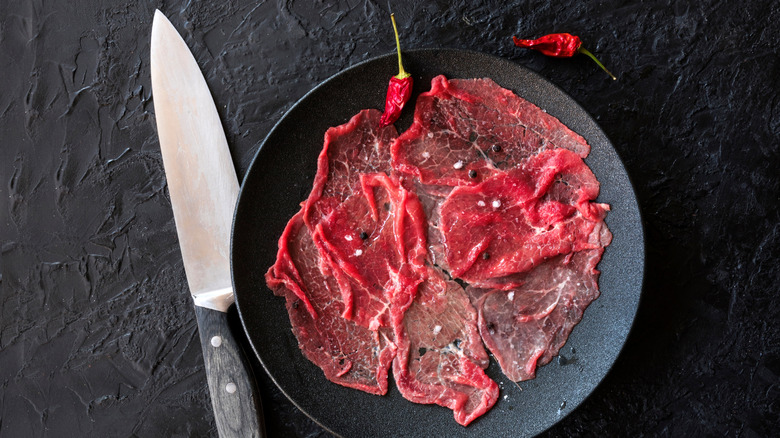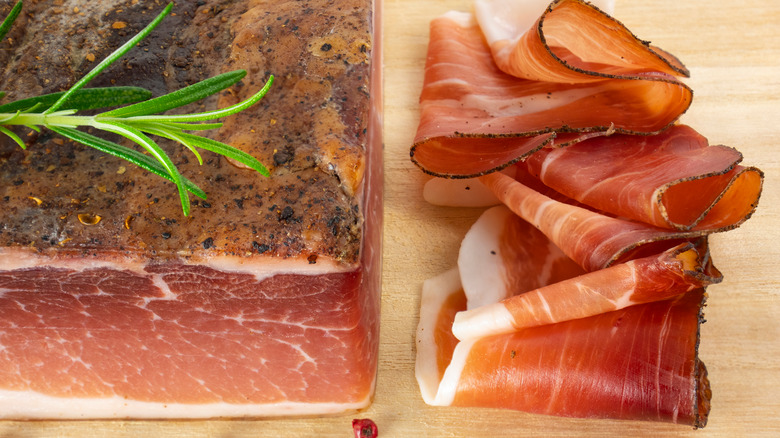Ina Garten's Easy Trick For Ultra-Thin Meat Slices
We may receive a commission on purchases made from links.
Whether you're making a cheesesteak, a stir fry, pho, or grilled skewers, some recipes require you to start cooking with thin slices of meat rather than thick chunks. And while it looks easy when a butcher does this with a professional slicer, it's much more difficult to get thin slices at home when cutting by hand.
When the recipe in question is something like carpaccio – where the raw beef filet slices are served wafer-thin — it's even more tricky. But culinary queen Ina Garten has a top tip for slicing the raw meat that can help prevent the finished dish from looking like a clumsy culinary disaster (and hopefully reduce the risk of any potential knife-slipping accidents in the process). Essentially, it involves freezing the meat for a short time before it's sliced.
Slicing a lightly seared filet for carpaccio by hand means it will "never be paper thin," Garten admits in her "Cook Like A Pro" cookbook, "but freezing it makes it so much easier." This is because the short spell in the freezer means the meat is firmer and easier to handle than fridge-cold meat. And it's a technique that can be applied to other raw meats where you need thin slices, too — whether it's bacon, pork, chicken, steak, or even salmon.
Ina Garten quickly freezes her meat for easier slicing
When raw meat is at room temperature, it's soft — slippery. This texture makes it difficult to hold the meat still on the board, and even trickier to get thin slices. When it's fridge-cold, the meat is easier to handle, but still hard to slice thinly. But freezing results in a piece of protein that's much firmer — and that remains still on the cutting board while you hold it, making slicing a breeze.
Obviously, you don't want the meat to be frozen solid, as it would be pretty much impossible to slice. So timing is key. Ina Garten recommends two hours in the freezer for the filet of beef for her carpaccio, which has been trimmed, tied, quickly seared, and wrapped in plastic wrap. But up to 30 minutes will generally suffice for meat that's firmed up just enough that you can cut it. Just pat the meat dry and pop it on a baking tray lined with parchment paper before sticking it in the freezer.
If your meat has spent too long in the freezer and is overly hard, simply remove it, and let it partially defrost before slicing. This method also works if you want to prepare something like a carpaccio in advance, as you can remove the fully frozen filet from the freezer and let it start to deforest before slicing and serving — just don't leave meat out for more than two hours (per the USDA).
Other tips for thinly slicing raw, cured, and cooked meats
It goes without saying that a sharp knife is essential if you want to get the thinnest, most even meat slices. Ina Garten explains in her "Cook Like A Pro" cookbook that she generally recommends an eight to 10-inch carving knife for slicing meats; for her raw beef carpaccio dish, which requires paper-thin slices, she suggests a sharp slicing or smoked salmon knife. Just make sure your full-tang kitchen knife is sharp, and avoid serrated blades, which can cause uneven results.
For something like a carpaccio — where the filet has been wrapped in plastic wrap before going in the freezer — you may find it easier to get thin slices by keeping the wrap on as you slice to help keep its shape. Just remember to remove any pieces before serving, and slice it across the grain. You can always lay the slices between two pieces of parchment paper and roll them with a rolling pin for ultra-thin results.
A piece of meat that has already been cooked doesn't need to go in the freezer before slicing — though letting it rest on a cutting board will help it to become firmer and keep its shape better for easier slices. But for softer cured meats such as ham or salami which require thin slices, chilling or lightly freezing the meat first will help. And bacon, with its soft fat, is definitely easier to slice when quickly semi-frozen.



